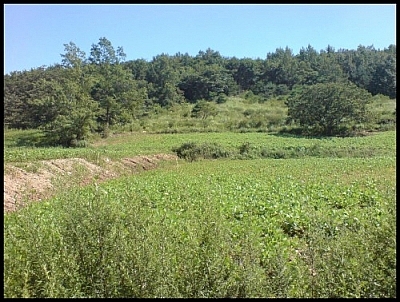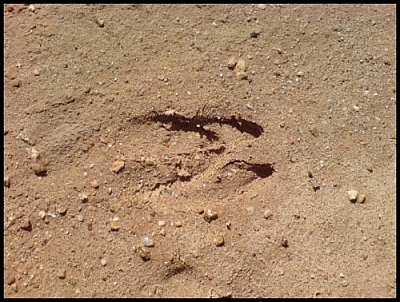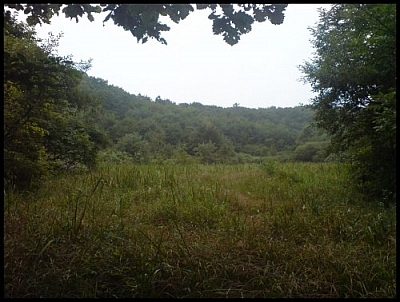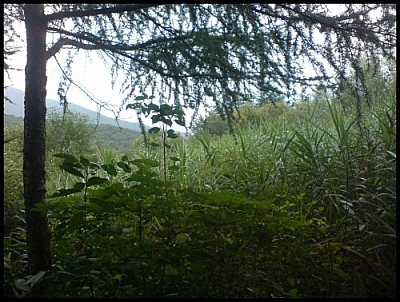Back in May, I had been on a three-day trek in Jirisan National Park, but now I was excited to access more restricted areas of the park and to learn about its ecology. I would be spending the weekend on an eco-tour as a volunteer with the Korea Wetland Project.
Day 1
I met my travel companions, Won-ho and Jae Jin, at Sasang subway station in Busan on the morning of August 15th. We expected to arrive at our destination, Wonji, well before the group arriving from Seoul. What should have been a two-hour bus ride took four hours due to vacation traffic. Nonetheless, we arrived in Wonji, where the rest of the group was awaiting us, ready to begin our Jirisan wetland eco-tour and learn about some of Korea’s most significant and ecologically important natural areas.
Private Wetland on the Jirisan Wetland Eco-Tour
After a hurried lunch, we hopped onto the tour bus and made our way to a private wetland area that had unfortunately been drained for farming. The farmer had discovered, however, that harvesting rice on this terrain was too difficult, so he was converting the lands to other use.

While contemplating the vast area, our guide for this leg of the tour, a professor at a Korean university and a wetlands specialist and field researcher, informed us that rain does not drain easily through rock, which is why there are so many wetlands in Korea’s mountains.
The professor then took us further into the field. Soon, we were trudging through peat land. I was surprised to feel my feet wet. Looking down, I noticed water surfacing above the spongy plant-covered ground. Hye-one, the Korea Wetland Project employee I’d been in touch with prior to the tour, stepped up to me and translated in a whisper:
“We are standing on one metre of water.”
The various plants and grasses growing in this part of the wetland were so thick that they enabled us to traverse the area while remaining on the surface.
“The trees are encroaching all around us; they are taking over the wetland. This means that the area is drying out.” Hye-one continued to translate as much as she could of the professor’s oration.
“Wetlands encourage biodiversity. Rats live here so birds of prey and other predators do, too. Do you know of the leopard cat? It is endangered in Korea.” In fact, I had never heard of the leopard cat and was completely unaware that there were any wild cats remaining on the peninsula, under the false impression that they had all been eradicated by hunting, war, and development. Discovering the existence of the leopard cat was a truly exciting moment for me.
Indeed, throughout the weekend, I discovered that Korea was home to many animal species that I had thought extinct on the peninsula, including boars.

As we walked back down the access road to our bus, one of the national parks guides halted the group to point out two sets of prints — those of a leopard cat and those of a Chinese water deer. Proof that even dying wetlands are ecologically important areas that help to preserve biodiversity, rendering their conservation all the more important.

Jungsanni Ranger Station and Evening Presentation

Our group was then taken to the Jungsanni Ranger Station, where we were given a tour of the visitors’ centre and taken on a nature walk. Most notably, during our brief walk we saw (and smelled) a tree whose leaves emit the same odour as ginger as well as a species of trees endemic to Jirisan. At the end of the tour, we had the opportunity to make fans using diverse leaves to impress colour and shape onto blank paper.

That night, drowsy from dinner, we attended a workshop which provided more details about wetlands. I learned that acid dissolves organic materials to create peat lands. Unfortunately, the presentation was quite scientific so it was difficult for my new friends to translate for me. I nevertheless gleaned some information from the photos, diagrams, charts, and graphs displayed, particularly regarding weather and precipitation disparities between the two wetlands we would be visiting on the following day.
I was astonished that the higher altitude wetland, Wangdeungjae, is wetter than the lower elevation one, Oegok. I imagined that gravity, if nothing else, would divert water into lower areas. Jin, another of my translators and an intern at the Korea Wetland Project, clarified things for me: “The professor said that wetlands control water flow at lower levels by retaining water.” Organic materials act as containers, preventing floods to lower lands while still allowing a steady supply to seep through.
Exhausted from the intensive first day of our Jirisan wetland eco-tour, sleep came easily that night.
Day 2
I awoke at 5 a.m., ready to continue our exploration of some of Jirisan’s most restricted areas. Our hosts packed breakfast for us, which we carried to the bus.
Traditional Village
Before setting off, we briefly toured the traditional village where we had spent the night.
Hye-one stood by me and, just like in the movies, translated sentence fragments for me, pausing her interpretation only long enough to listen for a few seconds at a time.
“Traditional villages were always formed by members of the same family, but we are in a unique village. This village was founded by members of different families. It is 1,000 years old.”
We were standing at the entrance to the village as we received this information. In the lane leading to the heart of the village, two massive 400-year-old trees crisscrossed each other, giving the illusion of a gate.
“Do you see the yellow flowers in the trees? They are used to make dye.”
We moved on and visited the courtyard of a traditional hanok home before boarding the bus and ravenously devouring our brown-bag breakfast.
The next destination on our Jirisan wetland eco-tour was 40 minutes away.
Wangdeungjae and Oegok Wetlands
Finally, the moment we’d all been waiting for arrived — at least, I assume we’d all been waiting for this, as I certainly had been! We were ready to begin our hike to two restricted wetlands.
I soon found myself at the head of the group, hiking with one of our national park guides, Yang Su Min. I occasionally paused to take photos of plants and flowers to fulfill my wetland monitoring duties.

At first, Yang Su Min and I walked in silence, but soon, we began to chatter endlessly. He told me of his experience on a training excursion in Petrified Forest National Park in Arizona and of how Korea and Canada’s national parks offices worked together in the past, approximately 100 Korean national parks employees going to Canada on a learning exchange.
I barely noticed time pass; to my great surprise, we arrived at the first wetland, Wangdeungjae, much sooner than I’d expected.

Wangdeungjae is the only well-preserved alkaline alpine wetland in Korea and it is approximately 1,500 years old. Here, the professor informed us that the wild boar’s preferred habitat is wetland. As part of his research on wetlands in Korea, one of his tasks is to locate new and unknown wetlands. Whenever he arrived at another village, he therefore sought out the oldest people in the village and asked them where the wild boars were usually seen. In this way, he could more easily locate wetlands.
The professor’s tone changed as he told us about the fragility of wetlands. Jin came up behind me, his look serious. “He is saying that some years ago, he and one other researcher walked all around the wetland to make a report, but then, the wetland was ruined that entire summer, just from them walking around.”
These areas are restricted to the public for very good reason. As ecologically important as they are, the risk of unknowingly damaging them is far too great. Well-meaning people, unaware of the consequences of their actions, could easily destroy these biologically rich areas.
At that moment, my eyes noticed something unnatural: trash. I picked it up — a plastic wrapper and a cigarette butt (smoking is not permitted in Korea’s national parks, yet the evidence of their use is everywhere). Yang Su Min took the trash from me, thanking me. Yet I saw more. And more. Another park ranger produced a refuse bag and we cleaned the area thoroughly before departing (luckily, there wasn’t all that much lying about).
As we continued our hike, Jin joined Yang Su Min and I at the front of the group. When we heard gunshots, we stopped and looked at each other, but Yang Su Min assured us that hunting is illegal in the park and that farmers use the noise to frighten animals away from their crops.
On we marched until we reached the next wetland, Oegok, a seemingly short distance away, all the while continuing to pick up trash on the rare occasions we saw some.

Here, the professor indicated that we were currently on the oldest mountain in Korea, despite the popular misconception that Baekdusan in North Korea holds that distinction. After a few minutes, Jin approached me, wide-eyed.
“There’s a religious group that does some annual ritual here, so they come hiking in this restricted area and they hunt, too. At that time of year, the national parks office conducts unscheduled checks to try and stop them.”
Hye-one, not far away, glanced up.
“No! He just gave you misinformation!” She chuckled. They had a short discussion, then Jin joined her and their laughter became louder. Eventually, Hye-one turned to me and said:
“There are sometimes hikers who come here illegally. That is all. There is no religious group or illegal hunting.”
Jin grinned, embarrassed. As Hye-one turned away, I comforted him.
“Well, your story was much better, far more interesting!”
We followed Yang Su Min towards the wetland. He pushed aside tall, thick vegetation to reveal two wooden runners crossing the wetland. We advanced deeper into Oegok, the grasses towering above us, using our arms to shield our faces as we stumbled forward. This was my kind of hiking! It would have been very difficult and wet without the wooden runners to follow; most of us were not wearing waterproof footwear so we were grateful for them.
Daewon Buddhist Temple
Our hike finished, we ate lunch on a balcony overlooking a beautiful stream where children were swimming and parents sat on the rocks, laughing. There was one activity left before we returned home.

A few hundred metres away from the restaurant, we had the opportunity to visit Daewonsa, a Buddhist temple. Notably, the four humongous statues of the temple guardians that usually adorn the last gate were missing. They had been removed for restoration. As we stood outside the main hall, one man remarked that while the colours and decorations of a temple are usually the same or similar, the doors of a temple are always adorned differently. No two temples have the same designs painted onto their doors, a fact I was unaware of despite having visited many temples.
In the centre courtyard of the temple, a photo exhibit of Jirisan National Park was on display. Most prominently featured were numerous photos of Manchurian black bears, approximately 20 to 50 of which are known to live within the park boundaries. Jin and I were excited, however, by the four photographs of Wangdeungjae wetland, one for each season. Jin pointed to the spring and summer representations. “What we saw today looked like the spring photo, even though it is summer.”
Baffled, we left the temple and boarded the bus home, our Jirisan wetland eco-tour complete.
This photo journal of my Jirisan wetland eco-tour was written as a volunteer for the Korea Wetland Project. In mid-August, I went on an all-Korean eco-tour of Jiri Mountain’s wetlands with the objective of writing a photo journal to attract more tourists to the eco-tours offered in all of Korea’s national parks. Check out my other photo journal for the Korea Wetland Project: Upo Marsh Circuit Hike.




Search Niackery
×